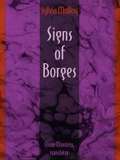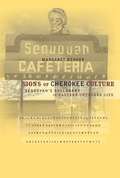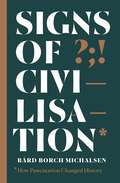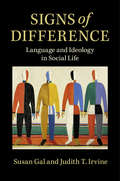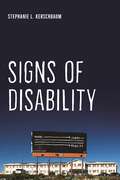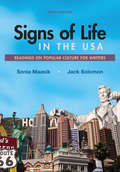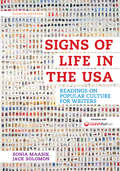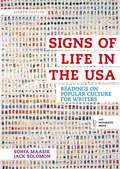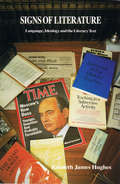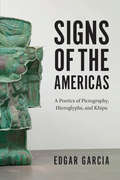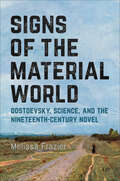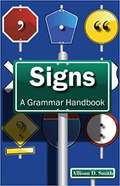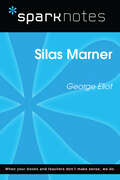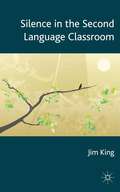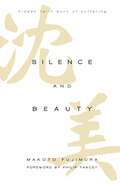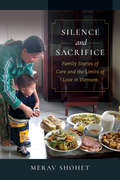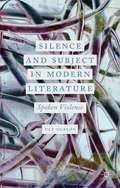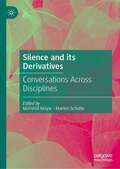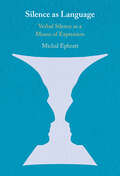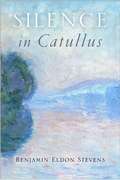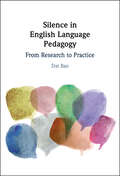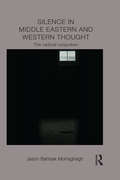- Table View
- List View
Signs of Borges
by Sylvia Molloy Oscar MonteroAvailable for the first time in English, Signs of Borges is widely regarded as the best single book on the work of Jorge Luis Borges. With a critical sensibility informed by Barthes, Lacan, Foucault, Blanchot, and the entire body of Borges scholarship, Sylvia Molloy explores the problem of meaning in Borges's work by remaining true to the uncanniness that is its foundation.Borges's sustained practice of the uncanny gives rise in his texts to endless tensions between illusion and meaning, and to the competing desires for fragmentation, dispersal, and stability. Molloy traces the movement of Borges's own writing by repeatedly spanning the boundaries of genre and cutting across the conventional separations of narrative, lyric and essay, fact and fiction. Rather than seeking to resolve the tensions and conflicts, she preserves and develops them, thereby maintaining the potential of these texts to disturb. At the site of these tensions, Molloy locates the play between meaning and meaninglessness that occurs in Borges's texts. From this vantage point his strategies of deception, recourse to simulacra, inquisitorial urge to unsettle binarism, and distrust of the permanent--all that makes Borges Borges--are examined with unmatched skill and acuity.Elegantly written and translated, Signs of Borges presents a remarkable and dynamic view of one of the most international and compelling writers of this century. It will be of great interest to all students of twentieth-century literature, particularly to students of Latin American literature.
Signs of Cherokee Culture
by Margaret BenderBased on extensive fieldwork in the community of the Eastern Band of Cherokee Indians in western North Carolina, this book uses a semiotic approach to investigate the historic and contemporary role of the Sequoyan syllabary--the written system for representing the sounds of the Cherokee language--in Eastern Cherokee life. The Cherokee syllabary was invented in the 1820s by the respected Cherokee Sequoyah. The syllabary quickly replaced alternative writing systems for Cherokee and was reportedly in widespread use by the mid-nineteenth century. After that, literacy in Cherokee declined, except in specialized religious contexts. But as Bender shows, recent interest in cultural revitalization among the Cherokees has increased the use of the syllabary in education, publications, and even signage. Bender also explores the role played by the syllabary within the ever more important context of tourism. (The Eastern Cherokee Band hosts millions of visitors each year in the Great Smoky Mountains.) English is the predominant language used in the Cherokee community, but Bender shows how the syllabary is used in special and subtle ways that help to shape a shared cultural and linguistic identity among the Cherokees. Signs of Cherokee Culture thus makes an important contribution to the ethnographic literature on culturally specific literacies.
Signs of Civilisation: How punctuation changed history
by Bård Borch Michalsen'Punctuation is not only an important part of our language code; an advanced system of punctuation has been a driving force in our entire Western Civilisation. Nothing less.'With the invention of printing, reading books moved from being an act only performed by priests and aristocrats into an individual, even private, activity. This change helped spark the Renaissance, the Reformation, the Enlightenment and the Industrial Revolution - in which punctuation played a crucial role. As long as texts were read out loud only by an educated elite there was no need for punctuation to mark pauses, full stops or questions.So punctuation - the full stop, the comma, the exclamation mark, the question mark and the semicolon - helped shape modern-day Europe as we know it.
Signs of Civilisation: How punctuation changed history
by Bård Borch Michalsen'Punctuation is not only an important part of our language code; an advanced system of punctuation has been a driving force in our entire Western Civilisation. Nothing less.'With the invention of printing, reading books moved from being an act only performed by priests and aristocrats into an individual, even private, activity. This change helped spark the Renaissance, the Reformation, the Enlightenment and the Industrial Revolution - in which punctuation played a crucial role. As long as texts were read out loud only by an educated elite there was no need for punctuation to mark pauses, full stops or questions.So punctuation - the full stop, the comma, the exclamation mark, the question mark and the semicolon - helped shape modern-day Europe as we know it.
Signs of Difference: Language and Ideology in Social Life
by Susan Gal Judith T. IrvineHow are peoples' ideas about languages, ways of speaking and expressive styles shaped by their social positions and values? How is difference, in language and in social life, made - and unmade? How and why are some differences persuasive as the basis for action, while other differences are ignored or erased? Written by two recognised authorities on language and culture, this book argues that ideological work of all kinds is fundamentally communicative, and that social positions, projects and historical moments influence, and are influenced by, people's ideas about communicative practices. Neither true nor false, ideologies are positioned and partial visions of the world, relying on comparison and perspective; they exploit differences in expressive features - linguistic and otherwise - to construct convincing stereotypes of people, spaces and activities. Using detailed ethnographic, historical and contemporary examples, this outstanding book shows readers how to analyse ideological work semiotically.
Signs of Disability (Crip #4)
by Stephanie L. KerschbaumHow can we learn to notice the signs of disability?We see indications of disability everywhere: yellow diamond-shaped “deaf person in area” road signs, the telltale shapes of hearing aids, or white-tipped canes sweeping across footpaths. But even though the signs are ubiquitous, Stephanie L. Kerschbaum argues that disability may still not be perceived due to a process she terms “dis-attention.”To tell better stories of disability, this multidisciplinary work turns to rhetoric, communications, sociology, and phenomenology to understand the processes by which the material world becomes sensory input that then passes through perceptual apparatuses to materialize phenomena—including disability. By adding perception to the understanding of disability’s materialization, Kerschbaum significantly expands our understanding of disability, accounting for its fluctuations and transformations in the semiotics of everyday life.Drawing on a set of thirty-three research interviews focused on disabled faculty members’ experiences with disability disclosure, as well as written narratives by disabled people, this book argues for the materiality of narrative, suggesting narratives as a means by which people enact boundaries around phenomena and determine their properties. Signs of Disability offers strategies and practices for challenging problematic and pervasive forms of “dis-attention” and proposes a new theoretical model for understanding disability in social, rhetorical, and material settings.
Signs of Life in the U.S.A
by Sonia Maasik Jack SolomonSigns of Life in the USA works in the classroom because students love to talk and write about popular culture. Signs of Life teaches students to read and write critically about pop culture by providing them with a conceptual framework known as semiotics, a field of study developed specifically for the interpretation of culture and its signs. Signs of Life, written by a prominent semiotician and an experienced writing instructor, has been extensively updated to account for the rapid evolution of contemporary trends and student interests. It features insightful themes with provocative and current reading selections that ask students to think analytically about America's popular culture with questions such as: How has niche advertising impacted minorities? How has have television and the Internet shaped our current political climate? Signs of Life provides students with the academic language necessary to analyze the significance of our shared cultural experiences.
Signs of Life in the U.S.A.
by Sonia Maasik Jack SolomonPACKAGE THIS TITLE WITH OUR 2016 MLA SUPPLEMENT, Documenting Sources in MLA Style (package ISBN-13: 9781319084745). Get the most recent updates on MLA citation in a convenient, 40-page resource based on The MLA Handbook, 8th Edition, with plenty of models. Browse our catalog or contact your representative for a full listing of updated titles and packages, or to request a custom ISBN. Instructors who have used Signs of Life in the USA know that students love to talk and write about popular culture. They can attest that it teaches students to read and write critically about pop culture by providing them with a conceptual framework: semiotics, a field of study developed specifically for the interpretation of culture and its signs. Signs of Life is written by a prominent semiotician and an experienced writing instructor, and it has been extensively updated to account for the rapid evolution of contemporary trends and student interests. It features insightful themes with provocative and current reading selections that ask students to think analytically about America's popular culture: How has niche advertising been used to develop a highly detailed profile of your consumer habits? Why are Americans so transfixed by "bad guys"? Signs of Life bridges the transition to college writing by providing students with academic language to talk about the significance of our shared cultural experiences. And now with the new edition, you can meet students where they are: online. Our newest set of online materials, LaunchPad Solo, provides all the key tools and course-specific content that you need to teach your class. Get all our great course-specific materials in one fully customizable space onli≠ then assign and mix our resources with yours. To package LaunchPad Solo free with Signs of Life in the USA, use ISBN 978-1-319-01383-7.
Signs of Life in the U.S.A.: Readings on Popular Culture for Writers (Eighth Edition)
by Sonia Maasik Jack SolomonSigns of Life is written by a prominent semiotician and an experienced writing instructor, and it has been extensively updated to account for the rapid evolution of contemporary trends and student interests. It features insightful themes with provocative and current reading selections that ask students to think analytically about America’s popular culture: How has niche advertising been used to develop a highly detailed profile of your consumer habits? Why are Americans so transfixed by "bad guys"? Signs of Life bridges the transition to college writing by providing students with academic language to talk about the significance of our shared cultural experiences.
Signs of Literature: Language, Ideology and the Literary Text
by Kenneth James HughesThis language primer begins with a suitably esoteric-looking chapter called "The Language of Time. " It isn't until the second paragraph that the unsuspecting reader realizes Hughes is talking about the language of "Time" magazine, which he analyzes as a piece of fiction. Indeed, for Hughes, there is no such thing as a substantive distinction between fiction and non-fiction--there are only texts that do things with structural techniques of syntax and signs. Some of these texts we have commonly agreed to believe are fiction; others we have commonly agreed to believe are fact. None of these texts, however, has anything to do with truth, much less Truth with a capital "T. " In an amazing brief and headlong rush through the history of language from classical Greece to the 20th century, Hughes demonstrates convincingly that neither the empirical world, nor the metaphysical world, has ever informed language. Rather, it is always language which informs the world. Hughes's careful analysis of the techniques of the English language, from Anglo-Saxon verse to the latest post-modern text, constantly reminds us that language is always a made thing, and that the empirical objects captured by language are never immediate, but always mediated by the perception and the craft of the speaker or the author. This book is a must for every serious student of language and literature: because it introduces the reader so effortlessly to the latest vocabulary and techniques of structuralist criticism, it is a basic tool for anyone wishing to communicate his or her ideas to anyone else, and in any discipline. The surprise of the book for the lay reader is that it is so richly entertaining. Its constant demystification of the technique of communication we most take for granted--common speech--offers the reader surprise and delight from the first page to the last.
Signs of the Americas: A Poetics of Pictography, Hieroglyphs, and Khipu
by Edgar GarciaIndigenous sign-systems, such as pictographs, petroglyphs, hieroglyphs, and khipu, are usually understood as relics from an inaccessible past. That is far from the truth, however, as Edgar Garcia makes clear in Signs of the Americas. Rather than being dead languages, these sign-systems have always been living, evolving signifiers, responsive to their circumstances and able to continuously redefine themselves and the nature of the world. Garcia tells the story of the present life of these sign-systems, examining the contemporary impact they have had on poetry, prose, visual art, legal philosophy, political activism, and environmental thinking. In doing so, he brings together a wide range of indigenous and non-indigenous authors and artists of the Americas, from Aztec priests and Amazonian shamans to Simon Ortiz, Gerald Vizenor, Jaime de Angulo, Charles Olson, Cy Twombly, Gloria Anzaldúa, William Burroughs, Louise Erdrich, Cecilia Vicuña, and many others. From these sources, Garcia depicts the culture of a modern, interconnected hemisphere, revealing that while these “signs of the Americas” have suffered expropriation, misuse, and mistranslation, they have also created their own systems of knowing and being. These indigenous systems help us to rethink categories of race, gender, nationalism, and history. Producing a new way of thinking about our interconnected hemisphere, this ambitious, energizing book redefines what constitutes a “world” in world literature.
Signs of the Material World: Dostoevsky, Science, and the Nineteenth-Century Novel
by Melissa FrazierSigns of the Material World traces the literary effects of nineteenth-century materialism that includes the mind and body within a multifaceted “living life.” The book examines a range of scientists, from Auguste Comte and the “vulgar” materialists to Charles Darwin, James Clerk Maxwell, George Henry Lewes, Charles Sanders Peirce, and the Russian Nikolai Strakhov.The book sets Fyodor Dostoevsky in complex opposition to his fellow writers, Lev Tolstoy and Nikolai Chernyshevsky, while also exploring the formal connections that he shares with contemporaries across Europe and the United States, including Wilkie Collins, Charles Dickens, George Eliot, Nathaniel Hawthorne, and Friedrich Schiller. Melissa Frazier argues that Dostoevsky’s art serves as his science, both in his reliance on plot and in his recourse to an often-extravagant figurative language.This combined literary and scientific practice reflects Dostoevsky’s transnational and interdisciplinary reading; it also transforms our own. In George Eliot’s words, Dostoevsky “changes the lights for us.” Once drawn into his orbit, Eliot herself no longer looks quite the same. Finally, Signs of the Material World argues that Eliot and Dostoevsky’s particular strain of nineteenth-century materialism lends itself to an ambivalent political stance, as they both confront the certainties of social utopianism with a deliberate embrace of ambiguity.
Signs: A Grammar Handbook
by Allison D. SmithAllison D. Smith and Fountainhead Press have teamed up to publish Signs: A Grammar Handbook, a low-cost, student-friendly grammar handbook. By focusing on essentials and eliminating wasteful content, such as unused and unwanted support material, we have created a quality textbook that costs half that of comparable offerings.
Silas Marner (SparkNotes Literature Guide Series)
by SparkNotesSilas Marner (SparkNotes Literature Guide) by George Eliot Making the reading experience fun! Created by Harvard students for students everywhere, SparkNotes is a new breed of study guide: smarter, better, faster. Geared to what today's students need to know, SparkNotes provides: *Chapter-by-chapter analysis *Explanations of key themes, motifs, and symbols *A review quiz and essay topicsLively and accessible, these guides are perfect for late-night studying and writing papers
Silence In The Second Language Classroom
by Jim KingWhy are second language learners in Japan's universities so silent? This book investigates the perplexing but intriguing phenomenon of classroom silence and draws on ideas from psychology, sociolinguistics and anthropology to offer a unique insight into the reasons why some learners are either unable or unwilling to speak in a foreign language.
Silence and Beauty: Hidden Faith Born of Suffering
by Makoto Fujimura2017 Logos Bookstore Association Award for Christianity/Culture2017 Dallas Willard Center Book Award FinalistForeword INDIES 2016 Book of the Year Awards FinalistWorld Magazine's Best Books of 2016 Short List2016 Aldersgate Prize by the John Wesley Honors College at Indiana Wesleyan UniversityEvangelical Christian Publishers Association Top Shelf Book Cover Award14th Annual Outreach Magazine Resource of the Year, Counseling and RelationshipsMissio Alliance Essential Reading List of 2016
Silence and Sacrifice: Family Stories of Care and the Limits of Love in Vietnam
by Merav ShohetHow do families remain close when turbulent forces threaten to tear them apart? In this groundbreaking book based on more than a decade of research set in Vietnam, Merav Shohet explores what happens across generations to families that survive imperialism, war, and massive political and economic upheaval. Placing personal sacrifice at the center of her story, Shohet recounts vivid experiences of conflict, love, and loss. In doing so, her work challenges the idea that sacrifice is merely a blood-filled religious ritual or patriotic act. Today, domestic sacrifices—made largely by women—precariously knot family members together by silencing suffering and naturalizing cross-cutting gender, age, class, and political hierarchies. In rethinking ordinary ethics, this intimate ethnography reveals how quotidian acts of sacrifice help family members forge a sense of continuity in the face of trauma and decades of dramatic change.
Silence and Subject in Modern Literature: Spoken Violence
by Ulf OlssonWhy does interrogation silence its object and not make it speak? Silence vs speech is a central issue in classical and modern literary works. This book studies literary representations of the power relations in which we are forced to speak using a range of texts ranging from the modern crime novel, via classics, to avant-garde plays.
Silence and its Derivatives: Conversations Across Disciplines
by Mahshid Mayar Marion SchulteThis edited book examines silence and silencing in and out of discourse, as viewed through a variety of contexts such as historical archives, day-to-day conversations, modern poetry, creative writing clubs, and visual novels, among others. The contributions engage with the historical shifts in how silence and silencing have been viewed, conceptualized and recorded throughout the course of the twentieth and twenty-first centuries, then present a series of case studies from disciplines including linguistics, history, literature and culture, and geographical settings ranging from Argentina to the Philippines, Nigeria, Ireland, Morocco, Japan, South Africa, and Vietnam. Through these examples, the authors underline the thematic and methodological contact zones between different fields and traditions, providing a stimulating and truly interdisciplinary volume that will be of interest to scholars across the humanities.
Silence as Language: Verbal Silence as a Means of Expression
by Michal EphrattVerbal silence touches on every possible aspect of daily life. This book provides a full linguistic analysis of the role of silence in language, exploring perspectives from semantics, semiotics, pragmatics, phonetics, syntax, grammar and poetics, and taking into account a range of spoken and written contexts. The author argues that silence is just as communicative in language as speech, as it results from the deliberate choice of the speaker, and serves functions such as informing, conveying emotion, signalling turn switching, and activating the addresser. Verbal silence is used, alongside speech, to serve linguistic functions in all areas of life, as well as being employed in a wide variety of written texts. The forms and functions of silence are explained, detailed and illustrated with examples taken from both written texts and real-life interactions. Engaging and comprehensive, this book is essential reading for anyone interested in this fascinating linguistic phenomenon.
Silence in Catullus
by Benjamin Eldon StevensBoth passionate and artful, learned and bawdy, Catullus is one of the best-known and critically significant poets from classical antiquity. An intriguing aspect of his poetry that has been neglected by scholars is his interest in silence, from the pauses that shape everyday conversation to linguistic taboos and cultural suppressions and the absolute silence of death. In "Silence in Catullus," Benjamin Eldon Stevens offers fresh readings of this Roman poet's most important works, focusing on his purposeful evocations of silence. This deep and varied "poetics of silence" takes on many forms in Catullus's poetic corpus: underscoring the lyricism of his poetry; highlighting themes of desire, immortality-in-culture, and decay; accenting its structures and rhythms; and, Stevens suggests, even articulating underlying philosophies. Combining classical philological methods, contemporary approaches to silence in modern literature, and the most recent Catullan scholarship, this imaginative examination of Catullus offers a new interpretation of one of the ancient world's most influential and inimitable voices.
Silence in English Language Pedagogy: From Research to Practice
by Dat BaoSilence in language learning is commonly viewed negatively, with language teachers often struggling to interpret learner silence and identify whether it is part of communication, mental processing, or low engagement. This book addresses silence in language pedagogy from a positive perspective, translating research into practice in order to inform teaching and to advocate greater use of positive silence in the classroom. The first half of the book examines the existing research into silence, and the second half provides research-informed practical strategies and classroom tasks. It offers applicable principles for task design that utilises rich resources, which include visual arts, mental representation, poetry, music, and other innovative tools, to allow both silence and speech to express their respective and interrelated roles in learning. Comprehensive yet accessible, it is essential reading for academic researchers and students in applied linguistics, TESOL, and language teaching, as well as for language teachers and educators.
Silence in Middle Eastern and Western Thought: The Radical Unspoken (Intersections: Colonial and Postcolonial Histories)
by Jason Bahbak MohagheghPresenting an engaging reflection on the work of prominent modern Iranian literary artists in exchange with contemporary Continental literary criticism and philosophy, this book tracks the idea of silence – through the prism of poetics, dreaming, movement, and the body – across the textual imaginations of both Western and Middle Eastern authors. Through this comparative nexus, it explores the overriding relevance of silence in modern thought, relating the single concept of "the radical unspoken" to the multiple registers of critical theory and postcolonial writing. In this book, the theoretical works of Georges Bataille, Maurice Blanchot, Gaston Bachelard, Antonin Artaud, and Gilles Deleuze are placed into a charged global dialogue with the literary-poetic writings of Sadeq Hedayat, Ahmad Shamlu, Nima Yushij, Esmail Kho’i, and Forugh Farrokhzad. It also examines a vast spectrum of thematic dimensions including disaster, exhaustion, eternity, wandering, insurrection, counter-history, abandonment, forgetting, masking, innocence, exile, vulnerability, desire, excess, secrecy, formlessness, ecstasy, delirium, and apocalypse. Providing comparative criticism that traces some of the most compelling intersections and divergences between Western and Middle Eastern thought, this book is of interest to academics of modern Persian literature, postcolonial studies, Continental philosophy, and Middle Eastern studies.
Silence in Modern Literature and Philosophy: Beckett, Barthes, Nancy, Stevens
by Thomas GouldThis book discusses the elusive centrality of silence in modern literature and philosophy, focusing on the writing and theory of Jean-Luc Nancy and Roland Barthes, the prose of Samuel Beckett, and the poetry of Wallace Stevens. It suggests that silence is best understood according to two categories: apophasis and reticence. Apophasis is associated with theology, and relates to a silence of ineffability and transcendence; reticence is associated with phenomenology, and relates to a silence of listenership and speechlessness. In a series of diverse though interrelated readings, the study examines figures of broken silence and silent voice in the prose of Samuel Beckett, the notion of shared silence in Jean-Luc Nancy and Roland Barthes, and ways in which the poetry of Wallace Stevens mounts lyrical negotiations with forms of unsayability and speechlessness.
